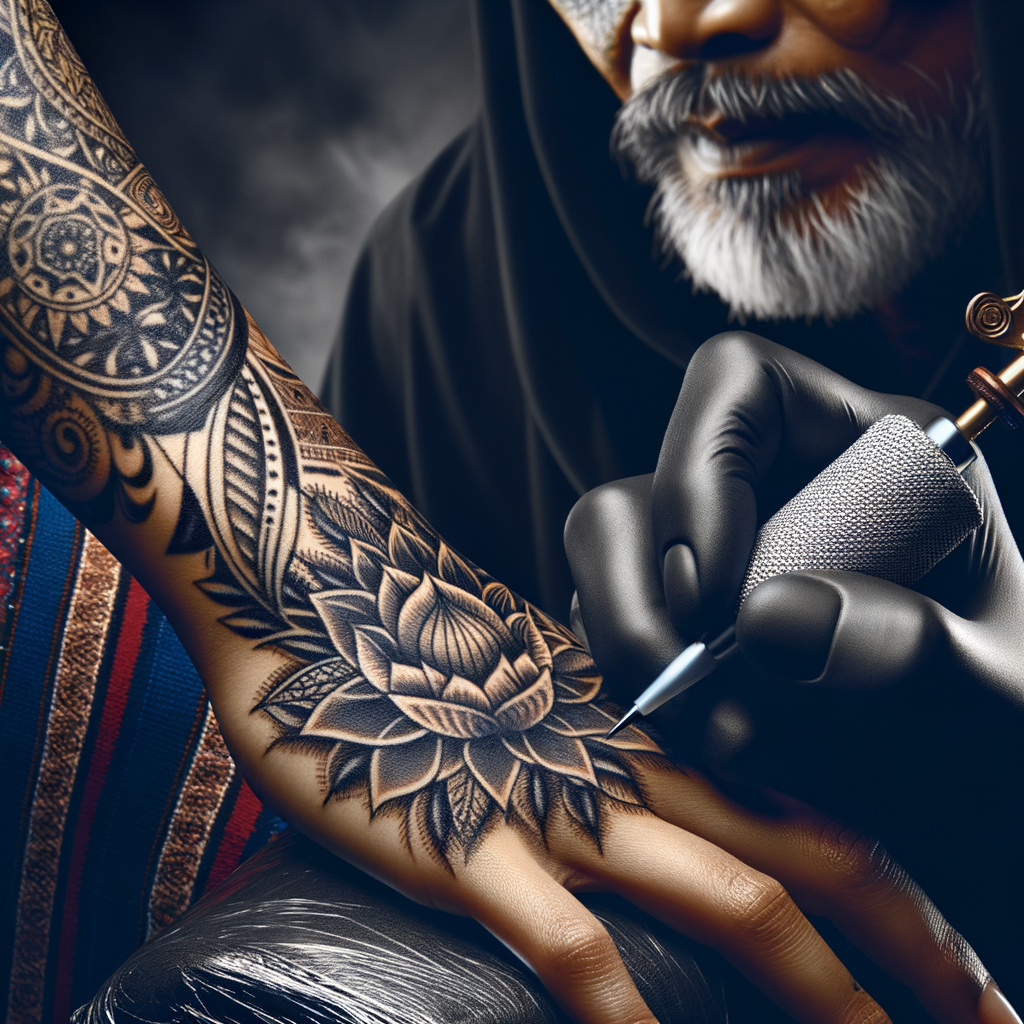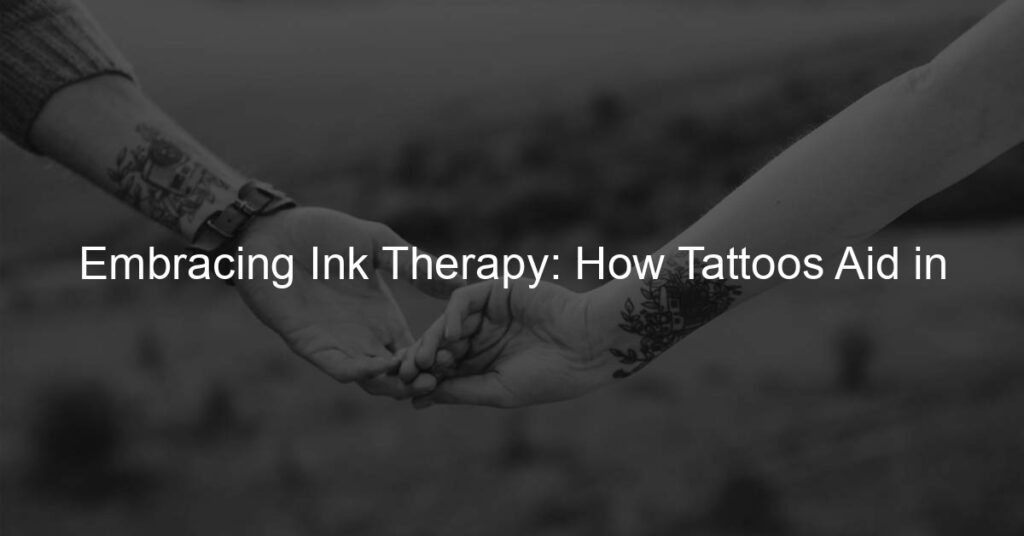
Introduction to Ink Therapy
Have you ever heard of ink therapy? It’s a fascinating concept that has been gaining popularity in recent years. This article will help you understand what ink therapy is and how tattoos have become a form of therapy for many people.
-
- Defining Ink Therapy
Ink therapy, also known as tattoo therapy, is the process of using tattoos as a form of self-expression and healing. It’s not just about getting a tattoo for the sake of aesthetics or trend. Instead, it’s about finding a deeper meaning and therapeutic value in the art of tattooing.
Many people find that getting a tattoo can help them cope with various emotional and mental health issues. It can serve as a reminder of a personal journey, a symbol of strength, or a tribute to a loved one. The act of getting a tattoo can also be a therapeutic process itself, as it allows individuals to take control of their bodies and express their feelings in a unique and permanent way.
-
- The Rise of Tattoos as Therapy
The use of tattoos as a form of therapy has been on the rise in recent years. According to a survey by the Pew Research Center, nearly 40% of millennials have at least one tattoo. Many of these individuals report that their tattoos have personal significance and have helped them deal with difficult times in their lives.
There are also numerous stories of individuals who have used tattoos as a form of therapy. For example, some cancer survivors get tattoos to cover scars and reclaim their bodies after treatment. Others get tattoos to commemorate a loved one or to symbolize their recovery from addiction or mental illness.
As the stigma around tattoos continues to decrease, more and more people are embracing ink therapy as a valid and beneficial form of self-expression and healing.
The Healing Art of Tattoos
When we think of tattoos, we often focus on their aesthetic appeal or the personal stories they tell. However, there’s another side to tattoos that’s equally fascinating – their healing power. This article explores the physical healing process of tattoos.
Physical Healing Process of Tattoos
Getting a tattoo is more than just receiving a piece of art on your skin. It’s a process that involves your body’s natural healing abilities. Let’s delve into the details.
-
- Understanding the tattooing process
The tattooing process involves inserting ink into the second layer of your skin, known as the dermis. This is done using a machine that punctures your skin between 50 and 3,000 times per minute with a tiny needle. The ink from the needle goes into the dermis, where it becomes permanent.
-
- How the body heals after getting a tattoo
Once the tattooing process is complete, your body’s healing mechanisms kick in. The skin around the tattooed area may become red and swollen, which is a normal part of the healing process. Your immune system works to repair the skin, while white blood cells “eat” the ink particles, which is why tattoos fade over time.
It’s important to follow aftercare instructions to ensure your tattoo heals properly. This includes keeping the area clean, moisturizing with a recommended lotion, and avoiding sun exposure. Remember, the healing process can take up to two weeks, so patience is key.
Understanding the physical healing process of tattoos can help you appreciate the artistry and resilience of your body. So, the next time you look at your tattoo or consider getting one, remember the incredible healing journey your body undergoes to make that art possible.
Emotional Healing through Tattoos
Many people find solace and emotional healing in the art of tattooing. Tattoos can serve as a form of therapy, helping individuals to express their feelings, commemorate significant life events, or symbolize personal growth. Let’s delve into the therapeutic effects of getting a tattoo and explore a case study that highlights the power of tattoos in emotional healing.
-
- The Therapeutic Effects of Getting a Tattoo
Tattoos can have a profound therapeutic effect on individuals. They can serve as a form of self-expression, allowing individuals to articulate their emotions, experiences, and identities in a visual and permanent way. This can be particularly beneficial for individuals who have experienced trauma or loss, as it provides a tangible way to process and express their feelings.
Moreover, the act of getting a tattoo can be a cathartic experience. The physical pain involved in the tattooing process can serve as a form of release, helping individuals to confront and overcome emotional pain. In this way, tattoos can facilitate emotional healing and personal growth.
-
- Case Study: Emotional Healing through Tattoos
Consider the story of Jane, a woman who used tattoo therapy to cope with the loss of her mother. After her mother’s death, Jane felt a profound sense of grief and loss. She decided to get a tattoo of a rose, her mother’s favorite flower, on her arm.
The process of getting the tattoo was a deeply emotional experience for Jane. It allowed her to express her grief, remember her mother, and find a sense of closure. The tattoo served as a permanent reminder of her mother, providing comfort and solace. Jane reported that the tattoo helped her to process her grief and facilitated her emotional healing.
In conclusion, tattoos can have a profound therapeutic effect, facilitating emotional healing and personal growth. Whether it’s through self-expression, catharsis, or commemoration, tattoos can serve as a powerful tool in the journey towards emotional healing.
Therapeutic Tattoos and Mental Health
Therapeutic tattoos have emerged as a unique and powerful tool in the realm of mental health recovery. They can serve as a constant reminder of resilience, strength, and the ability to overcome adversity. Let’s delve deeper into how tattoos can aid in mental health recovery and explore a case study that highlights the impact of tattoos on individuals suffering from Post Traumatic Stress Disorder (PTSD).
-
How Tattoos Can Aid in Mental Health Recovery
Tattoos, often seen as a form of self-expression, can also play a therapeutic role in mental health recovery. They can serve as a tangible symbol of a person’s journey, their battles, and their victories. When a person chooses a design that resonates with their experiences, it can help them feel more connected to their healing process.
For instance, a person suffering from depression might get a tattoo of a semicolon. This symbol has been widely adopted by those who have struggled with mental health issues, as it represents a sentence the author could have ended but chose not to. The author is you, and the sentence is your life.
Such tattoos can act as a daily reminder of their strength and resilience, providing a sense of empowerment and aiding in their recovery process.
-
Case Study: Tattoos and PTSD
One of the most compelling examples of the therapeutic impact of tattoos can be seen in individuals suffering from PTSD, a mental health condition triggered by a terrifying event. Tattoos can provide a form of solace and control to these individuals.
Consider the case of a war veteran named John. After returning from a tour of duty, John struggled with PTSD. He decided to get a tattoo of a warrior’s helmet on his arm. This tattoo served as a constant reminder of his strength and bravery, helping him cope with his condition.
John’s story is just one example of how tattoos can aid in the healing process. They can provide a sense of control over one’s body and mind, offer a form of self-expression, and serve as a constant reminder of one’s resilience and strength.
In conclusion, therapeutic tattoos can play a significant role in mental health recovery. They can provide a sense of empowerment, control, and resilience, aiding in the healing process. However, it’s important to remember that while tattoos can be a powerful tool, they should be used in conjunction with professional mental health treatment.
The Stigma Around Tattoo Therapy
Despite the growing acceptance of tattoos in our society, there still exists a stigma around tattoo therapy. This stigma is often fueled by misconceptions and outdated societal views. Let’s delve into these misconceptions and how society’s view on tattoos is changing.
- Common misconceptions about tattoos
One of the most common misconceptions about tattoos is that they are a sign of rebellion or deviance. This stereotype has been perpetuated by media and popular culture, painting a picture of tattooed individuals as ‘bad boys’ or ‘troublemakers’. However, this is far from the truth. Many people get tattoos as a form of self-expression, to commemorate a significant event or person, or as a form of therapy.
Another misconception is that tattoos are unhealthy or unsafe. With advancements in technology and stringent health and safety regulations, the process of getting a tattoo is safer than ever. Professional tattoo artists use sterilized equipment and high-quality inks to ensure the safety and satisfaction of their clients.
- How society’s view on tattoos is changing
Over the past few decades, society’s view on tattoos has been gradually changing. Tattoos are becoming more accepted in professional settings, with many companies adopting more relaxed dress codes and attitudes towards body art.
Moreover, the perception of tattoos as a form of therapy is also gaining recognition. Tattoos can serve as a powerful tool for individuals dealing with trauma, grief, or mental health issues. They can provide a sense of control and empowerment, helping individuals to reclaim their bodies and express their emotions in a tangible way.
According to a survey conducted in 2020, around 30% of Americans have at least one tattoo, up from just 20% in 2012. This increase reflects the shifting attitudes towards tattoos and their growing acceptance in our society.
While there is still work to be done to fully eradicate the stigma around tattoo therapy, the progress made so far is promising. As more people share their positive experiences with tattoo therapy, it is hoped that these misconceptions will continue to be challenged and society’s view on tattoos will continue to evolve.
How to Embrace Tattoo Therapy
Embracing tattoo therapy is a personal journey that can lead to profound healing. It involves choosing the right tattoo and finding a skilled tattoo artist who understands your healing journey. Let’s delve into how to choose the right tattoo for your therapy.
Choosing the Right Tattoo for Healing
Choosing the right tattoo for therapy is a crucial step in your healing journey. It’s not just about picking a design you like; it’s about choosing a symbol that resonates with your personal healing process.
-
- Considerations when choosing a tattoo for therapy
When choosing a tattoo for therapy, consider the following:
-
-
- Symbolism: The tattoo should have a personal meaning or symbolism that aligns with your healing journey.
- Location: Choose a spot on your body that you’re comfortable with. The location of the tattoo can have a significant impact on your healing process.
- Size: The size of the tattoo should be appropriate. A too large or too small tattoo might not serve its therapeutic purpose.
- Case study: The healing journey of a tattoo enthusiast
-
Let’s take a look at the healing journey of Jane Doe, a tattoo enthusiast. Jane got her first tattoo after overcoming a difficult period in her life. She chose a phoenix design, symbolizing rebirth and renewal, and had it tattooed on her back. The process of getting the tattoo was therapeutic for Jane, and she felt a sense of closure and healing every time she looked at it. This case study highlights the power of tattoos in personal healing.
In conclusion, choosing the right tattoo for therapy involves careful consideration of the tattoo’s symbolism, location, and size. It’s about choosing a design that resonates with your personal healing journey and finding a skilled tattoo artist who can bring your vision to life.
Finding a Tattoo Artist
Choosing the right tattoo artist is a crucial step in your healing journey. The artist you choose will not only create the design on your skin, but they will also play a significant role in your therapy process. Here are some things to consider when selecting a tattoo artist.
-
- What to look for in a tattoo artist
When choosing a tattoo artist, there are several key factors to consider. First, you want to ensure that the artist is skilled and experienced. Look at their portfolio to see examples of their work. Are the lines clean and precise? Is the shading smooth and consistent? These are signs of a skilled artist.
Secondly, hygiene is of utmost importance. The studio should be clean, and the artist should use new, sterilized needles for each client. This is important to prevent infections and ensure your safety.
Lastly, a good tattoo artist should be a good listener. They should take the time to understand your vision and your healing journey. This will help them create a design that resonates with you and aids in your therapy process.
-
- How to find a tattoo artist who understands your healing journey
Finding a tattoo artist who understands your healing journey can be a bit more challenging. You want someone who is empathetic and understanding, someone who respects your journey and wants to help you heal.
One way to find such an artist is through word of mouth. Ask around in your community or online. People who have had a positive experience with their tattoo artist are usually more than happy to recommend them.
Another way is to meet with the artist before committing. During this meeting, explain your healing journey and why you want a tattoo. Their reaction will give you a good idea of whether they are the right fit for you.
In conclusion, finding the right tattoo artist is a crucial step in your healing journey. The right artist will not only create a beautiful design on your skin, but they will also understand and respect your healing journey. Take your time, do your research, and trust your instincts. You’ll know when you’ve found the right one.
Conclusion: The Power of Tattoos in Personal Healing
As we reach the end of our exploration into the world of ink therapy, it’s clear that tattoos hold a unique and powerful role in personal healing. Let’s take a moment to revisit the key points we’ve covered and reflect on the transformative potential of tattoo therapy.
-
- Recap of the benefits of tattoo therapy
Tattoo therapy, or ink therapy, is a creative and personal way to navigate the journey of healing. It serves as a form of self-expression, allowing individuals to tell their stories, commemorate important life events, or symbolize their personal growth. It can also be a therapeutic process, helping people cope with trauma, mental health issues, and physical ailments. The act of getting a tattoo can provide a sense of control and empowerment, which can be particularly beneficial for those dealing with issues like anxiety and depression.
-
- Final thoughts on embracing ink therapy
Embracing ink therapy is a deeply personal decision. It’s about finding a unique way to express oneself and navigate the healing process. It’s important to remember that every person’s journey is different, and what works for one might not work for another. However, for those who find solace and strength in the art of tattooing, it can be a powerful tool in their healing journey.
As we’ve seen, the power of tattoos in personal healing is undeniable. They offer a unique way to cope with life’s challenges, providing a sense of control, empowerment, and personal expression. Whether it’s a small symbol of strength or a large piece commemorating a significant life event, every tattoo tells a story. And for many, that story is one of healing, growth, and resilience.
So, if you’re considering ink therapy, remember: it’s not just about the final product. It’s about the journey, the process, and the personal transformation that comes with it. Here’s to the power of tattoos in personal healing and the incredible stories they tell.






